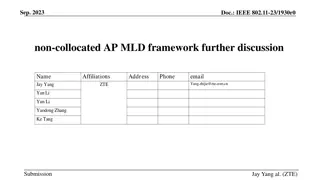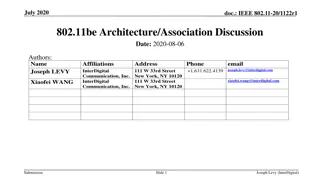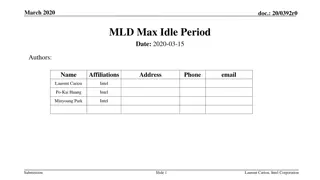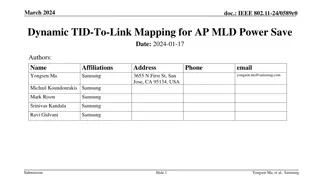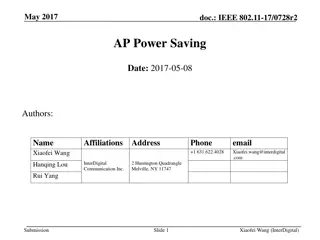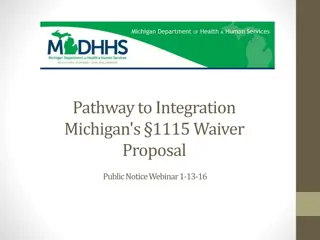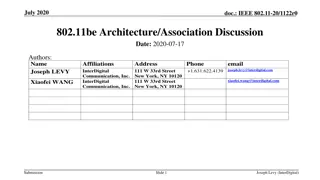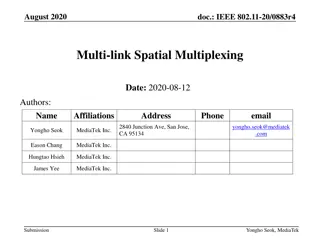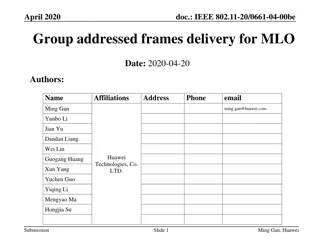
IEEE 802.11 Power-saving Considerations for Mobile APs
Explore power-saving considerations for mobile access points (APs) in the IEEE 802.11 standards. Topics include Multi-Link PS operation, Anchor/Primary channel mechanisms, probable designs, and proposed solutions for efficient power usage. Discover how different PS modes impact mobile AP performance and energy consumption.
Download Presentation

Please find below an Image/Link to download the presentation.
The content on the website is provided AS IS for your information and personal use only. It may not be sold, licensed, or shared on other websites without obtaining consent from the author. If you encounter any issues during the download, it is possible that the publisher has removed the file from their server.
You are allowed to download the files provided on this website for personal or commercial use, subject to the condition that they are used lawfully. All files are the property of their respective owners.
The content on the website is provided AS IS for your information and personal use only. It may not be sold, licensed, or shared on other websites without obtaining consent from the author.
E N D
Presentation Transcript
July 2020 Doc.: IEEE 802.11-20/1115r0 MLD AP Power-saving (PS) Considerations Date: 2020-07-xx Authors: Name Jay Yang Affiliations Nokia Address Phone email Zhijie.yang@nokia-sbell.com Prabodh Varshney Mika Kasslin Gang Cheng Yiming Jiang Dingjun He Submission Slide 1 Jay Yang (Nokia)
July 2020 Doc.: IEEE 802.11-20/1115r0 Background In 802.11ax and the previous SPEC, a lot of PS at STA side had be defined, such as (D)TIM, WMM-PS, WNM-PS, TWT, intra-PPDU and so on. Multi-Link feature becomes a hot candidate feature being discussed in TGbe group References [1,2,3] have made a lot of contributions on Multi-Link PS operation. To address the issue that the power consumption increase linearly with the number of links , References [2] and [3] introduce Anchor/Primary channel mechanism. In this presentation, we want to talk about different kinds of PS mode at the MLD AP side based on the concept of Anchor/Primary channels, especially for mobile APs or repeaters powered by battery. Submission Slide 2 Jay Yang (Nokia)
July 2020 Doc.: IEEE 802.11-20/1115r0 Probable design for mobile APs Mobile APs wake up at TBTT(LP->FP) and then switch to sleep mode(FP->LP) after sending out Beacon frame in idle state. A Mobile AP will stay at FP mode if any STA connects to it. Submission Slide 3 Jay Yang (Nokia)
July 2020 Doc.: IEEE 802.11-20/1115r0 Proposed solution for the MLD AP in PS mode A MLD device can set up more than one link according to 802.11be SFD. That s to say, any AP affiliated to the same MLD AP will not be able to enter PS mode even if all associated STAs within the same MLD STA on the same channel are in PS mode. It will consume too much power at the MLD AP side. We propose to define a mechanism that allow the AP within the MLD AP to enter PS mode if the following conditions are met 1) The AP work on the non-primary channel 2) NO non-MLD devices connected to the AP Since a non-MLD device only has one link connected to the MLD AP, so the AP needs to be kept in awake state to receive UL traffic in time. Slide 4 Submission Jay Yang (Nokia)
July 2020 Doc.: IEEE 802.11-20/1115r0 Proposed solution for MLD AP in PS mode (cont. ) Implicit mode: The AP within the MLD AP cannot enter PS mode unless all STAs within the MLD STA on the link stay in PS mode, and need to wake up before any STA exit PS mode or TBTT time comes. Submission Slide 5 Jay Yang (Nokia)
July 2020 Doc.: IEEE 802.11-20/1115r0 Proposed solution for MLD AP in PS mode (cont. ) Explicit mode: Define a signal which can be sent or indicated by the AP within the same MLD AP on the primary channel that indicates the AP on the non-primary channel enters PS mode, and APs in this scenario can be woke up by any MLD STA on the primary channel. Op1: The AP on the non-primary channel announce it will enter PS mode in the DTIM time(Beacon frame) so that all associated STAs can wake up and receive this signal. Op2: The AP within the same MLD AP on the primary channel can indicate the PS-mode AP s status in the RNR or multi-BSSID IE. Signal TBD(consider reuse TWT IE) Submission Slide 6 Jay Yang (Nokia)
July 2020 Doc.: IEEE 802.11-20/1115r0 Summary Proposal to define a PS mechanism at the MLD AP side Introduction to two methods about MLD AP PS mode Submission Slide 7 Jay Yang (Nokia)
July 2020 Doc.: IEEE 802.11-20/1115r0 References [1] IEEE 802.11-19/1526r0 multi-link power save [2] IEEE 802.11-19/1510r0 power saving considering multi-link [3] IEEE 802.11-19/1988r3 Power Save for Multi-link Submission Slide 8 . Jay Yang (Nokia)
July 2020 Doc.: IEEE 802.11-20/1115r0 SP 1 Do you agree to define a mechanism or signal to indicate that the MLD AP enters PS mode? Submission Slide 9 Jay Yang (Nokia)
July 2020 Doc.: IEEE 802.11-20/1115r0 SP 2 Do you agree to set certain conditions under which APs within the MLD AP can enter PS mode, and STAs within the MLD STA can wake up the PS-mode AP through the primary channel (Implicit mode)? Conditions: 1) The AP works on the non-primary channel 2) No non-MLD STAs connected to the AP 2) Sleep time should be within all STAs doze time Submission Slide 10 Jay Yang (Nokia)
July 2020 Doc.: IEEE 802.11-20/1115r0 SP 3 Do you agree to set certain conditions under which APs affiliated to the MLD AP can announce to enter PS mode, and STAs within the MLD STA can wake up through the primary channel? The announcement can be sent or indicated by the AP planning to enter PS mode in DTIM on the non-primary channel or the AP within the same MLD AP on primary channel (Explicit mode)? Conditions: 1) The AP work on the non-primary channel 2) No non-MLD STAs connected to the AP affiliated to the MLD AP Note: Signaling TBD Submission Slide 11 Jay Yang (Nokia)

